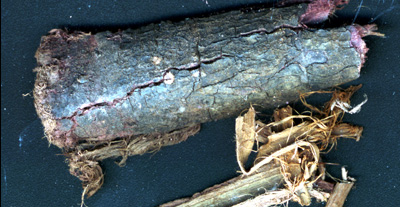
Shamanic Understanding:
"What is fascinating to consider is how these early shamans figured out that a potent brew could best be made from these two ingredients being mixed together."
ayauhasca.us
Ayahuasca also introduced the notion to the world that other combinations of plants might be entheogens, and scientists are beginning to look at these other “anahuasca” combinations. Anahuasca is a term used to describe other entheogenic drinks made from tryptamine-rich plants and plants containing MAOIs. Tryptamine-filled plants are among the most common on the planet and there also exists a multitude of plants containing MAOIs, thus there might be millions of combinations possible.
Research in this area is so very new, but among the most exciting anahausaca possibilities are three very common species, Peganum harmala, Mimosa hostilis and Phalaris arundinacea (or any of a number of other common phalaris grass species). P. harmala contains large amounts of the beta-carbolines harmine and harmaline (both effective MAOIs), and Mimosa and Phalaris are extremely rich in tryptamines, including DMT.
We used to believe that finding ß-carbolines and DMT in plants would be very rare, and
now we are finding out that the facts are far from that. As Ott describes:
“Indeed, there are theoretically several many thousand possible combinations of two plant extracts which could yield an entheogenic potion analogous to ayahuasca.”
In fact given that some of these Western plant sources are actually higher in
concentrations of these ß-carbolines and various psychoactive tryptamines, these
anahuasca sources offer the Westerner a more sane and rational alternative than
disrupting the Amazonian any more than we already have.
In fact, North America contains numerous plant species from which anahuasca can be
easily made. Several weeds – Peganum harmala and Arundo donax – species so
prevalent they are invasive in fact – contain the ß-carbolines necessary for the creation of
a North American anahuasca. Tryptamine-rich plants, those containing DMT and also the
related 5MEO-DMT (NMT, etc.) are too numerous to list here. One most common are
the various species of phalaris grasses (Phalaris arundinacea, for example) – which grow
exceedingly well in the colder temperate regions of North America and are fortunately
suitable for any Middle American lawn. There are literally hundreds of plants on our
continent that contain the necessary alkaloids, with more being discovered every year.

Phalaris araundinacea growing exceedingly well in the Puget Sound area. Mow and brew.

Jurema - Mimosa tenuiflora (= hostilis) native to the north of Brazil.
Mimosa tenuiflora also known as Jurema, is dried Mexican Mimosa tenuiflora root bark has been recently shown to have a DMT (Dimethyltryptamine) content of about 1%.[3] The stem bark has about 0.03% DMT.[18] The bark is the part of the tree traditionally used in northeastern Brazil in a psychoactive decoction also called Jurema or Yurema. Analogously, the traditional Western Amazonian sacrament Ayahuasca is brewed from indigenous ayahuasca vines. However, to date no β-carbolines such as harmala alkaloids have been detected in Mimosa tenuiflora decoctions, yet the root bark is consistently used without added MAOI.[wiki]
I can personal attest jurema gets one wildly high and the experience is similar to ayahuasca. [Muraco Kyashna-tocha]
At least one Israeli scholar has noted that all three plants are common in the Middle East and has questioned whether the knowledge of their shamanic potential wasn’t known. One such possible concoction is P. harmala and Mimosa hostilis – both of which are common throughout parts of the Mediterranean and Middle East, including the Judeo-Christian homelands of the southern region of Israel/Palestine and the Sinai Peninsula. The former residents of the region including the ancient Egyptians and Israelites considered Mimosa hostilis to be of special significance, well noted in the Scriptures, as both the tabernacle and the Ark of the Covenant were made out of mimosa wood. So were the caskets of the pharaohs. This occurs despite the fact that mimosa wood was not especially valuable, being instead quite common. Peganum harmala also hold significance throughout the region. The seeds are valued all across Asia Minor and India, where it is the medicine harmal. The data also suggests spiritual significance and Zoroastrians continue to believe it is a sacred plant. A potent anahuasca brew can be made from P. harmala and either M. hostilis or any of a number of phalaris grasses. Interestingly all these plants have now become rather common worldwide.
Mimosa hostilis also is shamanically used in a few parts of Columbia and Brazil. Called jurema, it was first characterized in use in 2001. A cold-water infusion is made from the plant and is orally active. This presents a challenge to the pharmacological understanding of how DMT from the plant is rendered orally active as an entheogen. In this view, if MAOI is neither present in the plant nor added to the mixture, the enzyme MAO will break apart DMT in the human gut, preventing the active molecule from entering blood and brain.
Mimosa hostilis also is shamanically used in a few parts of Columbia and Brazil. Called jurema, it was first characterized in use in 2001. A cold-water infusion is made from the plant and is said to be orally active.
Mimosa hostilis also is shamanically used in a few parts of Columbia and Brazil. Called jurema, it was first characterized in use in 2001. A cold-water infusion is made from the plant and is said to be orally active.